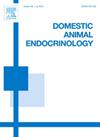Effect of GnRH administration on follicular development and ovulation during the early luteal phase in subtropical goats
IF 2.1
2区 农林科学
Q2 AGRICULTURE, DAIRY & ANIMAL SCIENCE
引用次数: 0
Abstract
This study aimed to evaluate the ovulatory response to GnRH treatment based on the day of its administration in the first follicular wave of the estrous cycle in goats. We hypothesized that maximum ovulatory response with GnRH treatment is dependent on the day of its administration during the early luteal phase of estrous cycle. Forty-eight goats were presynchronized with a single dose of PGF2α, and ultrasonography was performed to confirm ovulation (Day 0). Following ovulation, goats (n = 38) were randomly assigned to receive GnRH treatment on Days 2, 4, 6, or 8 of the estrous cycle. Follicular dynamics were assessed every 4 h after GnRH treatment and 37% of goats ovulated within 12.0 ± 1.5 h after treatment. Ovulation rate was significantly higher on Day 4 compared to Day 2 (P = 0.03) and gradually declined by Day 8. Goats with dominant follicles with diameters between 6.1 and 7.0 mm had significantly higher ovulation rate than goats < 6.1 mm (P = 0.01). A strong negative correlation was found between dominant follicle diameter at the time of GnRH administration and anovulation (rpb = -0.79). The growth rate of dominant follicles after GnRH administration remained higher in Day 4 than Day 8 (P < 0.05). Similarly, the interval to new follicular wave emergence was longer on Day 4 than on Days 2, 6 and 8 (P < 0.05). In conclusion, administering GnRH on Day 4 of the estrous cycle yielded the highest ovulatory response, particularly when the dominant follicle measured between 6.1-7.0 mm during the first follicular wave of estrous cycle.
GnRH对亚热带山羊黄体前期卵泡发育和排卵的影响。
本研究旨在评估GnRH治疗对山羊的排卵反应,基于在发情周期的第一个卵泡波中给药的日期。我们假设GnRH治疗的最大排卵反应取决于在发情周期的早期黄体期给药的日期。48只山羊预先注射单剂量的PGF2α,并进行超声检查以确认排卵(第0天)。排卵后,38只山羊(n = 38)随机分配在发情周期的第2、4、6或8天接受GnRH治疗。在GnRH治疗后每4小时评估一次卵泡动力学,37%的山羊在治疗后12.0±1.5小时内排卵。排卵率在第4天显著高于第2天(P = 0.03),在第8天逐渐下降。优势卵泡直径在6.1 ~ 7.0 mm的山羊的排卵率显著高于< 6.1 mm的山羊(P = 0.01)。GnRH给药时优势卵泡直径与无排卵呈显著负相关(rpb = -0.79)。GnRH给药后第4天优势卵泡生长速率高于第8天(P < 0.05)。与第2、6、8天相比,第4天出现新卵泡波的时间间隔更长(P < 0.05)。综上所述,在发情周期的第4天给予GnRH产生了最高的排卵反应,特别是当优势卵泡在发情周期的第一个卵泡波的6.1-7.0 mm之间时。
本文章由计算机程序翻译,如有差异,请以英文原文为准。
求助全文
约1分钟内获得全文
求助全文
来源期刊

Domestic animal endocrinology
农林科学-奶制品与动物科学
CiteScore
5.50
自引率
4.80%
发文量
58
审稿时长
31 days
期刊介绍:
Domestic Animal Endocrinology publishes scientific papers dealing with the study of the endocrine physiology of domestic animal species. Those manuscripts utilizing other species as models for clinical or production problems associated with domestic animals are also welcome.
Topics covered include:
Classical and reproductive endocrinology-
Clinical and applied endocrinology-
Regulation of hormone secretion-
Hormone action-
Molecular biology-
Cytokines-
Growth factors
 求助内容:
求助内容: 应助结果提醒方式:
应助结果提醒方式:


